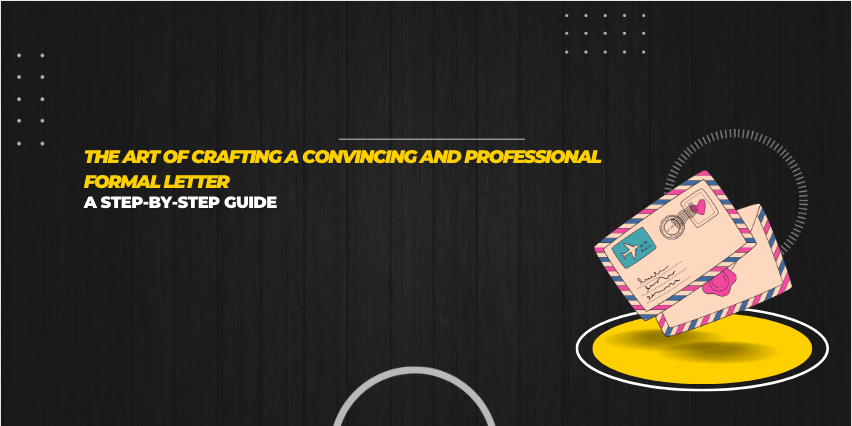
The Art of Crafting a Convincing and Professional Formal Letter: A Step-by-Step Guide
Importance of crafting a convincing and professional formal letter
In today’s digital age, where emails and instant messages dominate communication, the skill of crafting a convincing and professional formal letter may seem to be fading away. However, there are still situations where a well-written formal letter can make a lasting impression. Whether you’re applying for a job, making a complaint, or requesting information, knowing how to construct a compelling formal letter is an essential skill to have.
A convincing and professional formal letter not only showcases your ability to communicate effectively but also reflects your attention to detail and professionalism. It can make the difference between success and failure in various scenarios. For instance, when applying for a job, a strong cover letter can grab the attention of hiring managers and set you apart from other candidates. Similarly, a well-written complaint letter can prompt a resolution to your issue, and a thoughtfully crafted request letter can increase your chances of receiving the desired information.
Understanding the audience and purpose of your letter
Before you begin writing your formal letter, it’s crucial to understand your audience and the purpose of your letter. Identifying your audience will help you tailor the language, tone, and content of your letter to their specific needs and expectations. For example, if you’re writing to a potential employer, you’ll want to adopt a more formal tone and focus on highlighting your qualifications and skills. On the other hand, if you’re writing to a customer service representative, a more polite and respectful tone may be appropriate.
Additionally, understanding the purpose of your letter will help you structure your content effectively. Are you seeking information, expressing gratitude, making a complaint, or proposing a solution? Clearly defining your purpose will guide the overall tone and content of your letter, ensuring that it achieves its intended goal.
Structuring your formal letter
A well-structured formal letter is essential for clarity and readability. It helps the recipient navigate through the letter and understand its content without confusion. While there can be variations depending on the specific purpose of your letter, a typical formal letter usually follows a standard structure.
- Sender’s Information: Begin your formal letter by including your contact information, such as your full name, address, phone number, and email address. Place this information at the top of the letter, aligned to the left or right margin.
- Date: Provide the date on which you are writing the letter. This should be placed a few lines below your contact information.
- Recipient’s Information: Include the recipient’s contact information, such as their full name, job title, company name, and address. This information should be placed a few lines below the date, aligned to the left or right margin.
- Salutation: Start your letter with a formal salutation, such as “Dear Mr./Ms./Dr. [Last Name]” or “To Whom It May Concern” if you do not have a specific recipient. Use a colon (:) after the salutation.
- Body: The body of your letter should contain the main content and message. It is crucial to organize your thoughts and ideas clearly and logically. Use paragraphs to separate different points or ideas, ensuring that each paragraph focuses on a specific topic. Begin each paragraph with a topic sentence that summarizes the main point of the paragraph.
- Closing: End your letter with an appropriate closing, such as “Sincerely,” “Best regards,” or “Yours faithfully.” Leave a few lines of space for your signature. After the closing, type your full name and any additional contact information, such as your phone number or email address.
- Enclosure/Attachments: If you are including any additional documents with your letter, such as a resume or reference letters, mention them below your closing. For example, you can write “Enclosure: Resume” or “Attachments: Reference Letters.”
Writing a compelling opening paragraph
The opening paragraph of your formal letter plays a crucial role in capturing the reader’s attention and setting the tone for the rest of your letter. A strong opening paragraph should clearly state the purpose of your letter and provide a brief overview of what the reader can expect to find in the following paragraphs.
To make your opening paragraph compelling, consider using a hook or an attention-grabbing statement. This can be a thought-provoking question, a surprising fact, or a relevant quote. By engaging the reader from the beginning, you increase the chances of them continuing to read your letter with interest.
Additionally, it’s important to be concise and direct in your opening paragraph. Clearly state the reason for writing the letter and briefly explain the context or background if necessary. Avoid unnecessary details or long-winded explanations, as they can make your letter appear unfocused or unprofessional.
Developing clear and concise body paragraphs
The body paragraphs of your formal letter should contain the main content and message. It is essential to develop clear and concise paragraphs that effectively convey your ideas and arguments. Here are some tips to keep in mind when writing the body of your letter:
- Organize your thoughts: Before you start writing, outline the main points or ideas you want to address in your letter. This will help you organize your thoughts and ensure a logical flow of information. Each paragraph should focus on a specific point or idea, and there should be a clear transition between paragraphs.
- Use evidence and examples: To support your arguments or claims, use relevant evidence or examples. This can include statistics, research findings, personal experiences, or anecdotes. Providing evidence helps to strengthen your points and make your letter more persuasive.
- Be concise and to the point: Formal letters should be clear, concise, and straight to the point. Avoid using unnecessary words or overly complex language. Keep your sentences and paragraphs short and focused, making it easier for the reader to follow your message.
- Use bullet points or subheadings: If you need to present a list of items or ideas, consider using bullet points or subheadings. This helps to break up the text and make it more visually appealing and easier to read. It also allows the reader to quickly locate specific information.
- Consider the reader’s perspective: Put yourself in the reader’s shoes and consider their perspective. Anticipate any questions or concerns they may have and address them in your letter. By showing empathy and understanding, you can establish a connection with the reader and increase the effectiveness of your letter.
Using persuasive language and tone
The language and tone you use in your formal letter can greatly impact its effectiveness. To craft a convincing and professional letter, consider the following tips:
- Choose formal language: Formal letters require the use of formal language. Avoid slang, abbreviations, or overly casual expressions. Instead, opt for appropriate and professional vocabulary. Use complete sentences and ensure proper grammar and punctuation.
- Be polite and respectful: Maintain a polite and respectful tone throughout your letter. Use phrases such as “Please,” “Thank you,” and “I appreciate your consideration.” Avoid using aggressive or confrontational language, even if you’re expressing dissatisfaction or making a complaint.
- Use active voice: The active voice is more direct and engaging than the passive voice. It conveys a sense of action and responsibility. For example, instead of saying “Mistakes were made,” say “I made mistakes.” Using an active voice can make your letter more persuasive and assertive.
- Highlight benefits and solutions: When making a request or proposing a solution, focus on the benefits or advantages for the recipient. Explain how they can benefit from fulfilling your request or accepting your proposal. By emphasizing the positive outcomes, you make your letter more persuasive and compelling.
- Avoid exaggerations or false claims: While it’s important to present your case convincingly, avoid exaggerations or making false claims. Stick to the facts and provide evidence or examples to support your arguments. Exaggerations or false claims can undermine your credibility and make your letter less effective.
Concluding your formal letter effectively
The conclusion of your formal letter should leave a strong and positive impression on the reader. It should summarize the main points of your letter and reiterate your purpose or request. Here are some tips to help you conclude your letter effectively:
- Summarize your main points: Briefly summarize the main points or arguments you presented in the body of your letter. This helps to reinforce your message and remind the reader of the key information.
- Restate your purpose or request: Restate your purpose or request, emphasizing its importance or relevance. Make it clear what action you expect the recipient to take or what response you are seeking.
- Express gratitude or appreciation: If appropriate, express gratitude or appreciation for the recipient’s time, consideration, or assistance. A simple “Thank you for your attention to this matter” can leave a positive impression on the reader.
- Provide contact information: In case the recipient needs to reach you for further information or clarification, provide your contact information again. This includes your phone number, email address, and any other relevant details.
- End with a professional closing: Choose an appropriate closing for your letter, such as “Sincerely,” “Best regards,” or “Yours faithfully.” Sign your letter below the closing, using your full name.
Proofreading and editing your formal letter
Before sending your formal letter, it is crucial to proofread and edit it carefully. Your letter represents you and your professionalism, so it’s important to ensure that it is free from errors and typos. Here are some tips for effective proofreading and editing:
- Read your letter aloud: Reading your letter aloud can help you identify any awkward or unclear sentences. It also allows you to hear the flow and rhythm of your writing, making it easier to spot any issues.
- Check for spelling and grammar errors: Use a spell-check tool to catch any spelling errors, but also manually review your letter for grammar mistakes. Pay attention to subject-verb agreement, verb tense consistency, and punctuation.
- Ensure clarity and coherence: Make sure each sentence and paragraph flows smoothly and logically. Check for any confusing or ambiguous statements and revise them for clarity. Ensure that your ideas are presented in a logical order and that there are clear transitions between paragraphs.
- Trim unnecessary words or phrases: Review your letter for any unnecessary words or phrases that can be removed without changing the meaning. This helps to tighten your writing and make it more concise and impactful.
- Get a second opinion: If possible, ask someone else to read your letter and provide feedback. A fresh pair of eyes can often spot errors or suggest improvements that you may have missed.
Conclusion and final tips for crafting a convincing and professional formal letter
Crafting a convincing and professional formal letter is a valuable skill that can greatly enhance your communication abilities. By following the step-by-step guide shared in this article, you can master the art of writing formal letters that leave a positive impression.
Remember to always consider your audience and the purpose of your letter, structure your letter effectively, and use persuasive language and tone. Take the time to proofread and edit your letter, ensuring that it is error-free and coherent.
Lastly, practice makes perfect. The more you write formal letters, the more confident and skilled you will become. So, embrace opportunities to communicate through formal letters and continue honing your craft. With the right knowledge and practice, you can excel in crafting convincing and professional formal letters.
READ MORE
